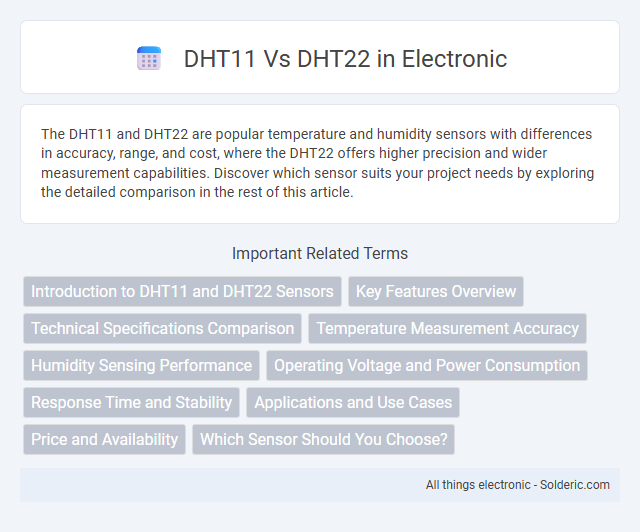The DHT11 and DHT22 are popular temperature and humidity sensors with differences in accuracy, range, and cost, where the DHT22 offers higher precision and wider measurement capabilities. Discover which sensor suits your project needs by exploring the detailed comparison in the rest of this article.
Comparison Table
| Feature | DHT11 | DHT22 |
|---|---|---|
| Temperature Range | 0 to 50degC | -40 to 80degC |
| Temperature Accuracy | +-2degC | +-0.5degC |
| Humidity Range | 20-80% RH | 0-100% RH |
| Humidity Accuracy | +-5% RH | +-2-5% RH |
| Sampling Rate | 1 Hz (1 reading/sec) | 0.5 Hz (1 reading/2 sec) |
| Operating Voltage | 3.5 to 5.5 V | 3.3 to 6 V |
| Cost | Low | Higher |
| Usage | Basic applications, budget projects | Advanced, high-accuracy applications |
Introduction to DHT11 and DHT22 Sensors
DHT11 and DHT22 are popular digital humidity and temperature sensors used in environmental monitoring and IoT applications. DHT11 offers a humidity range of 20-80% with +-5% accuracy and temperature measurement from 0 to 50degC with +-2degC precision, suitable for basic projects. DHT22 provides wider humidity detection from 0 to 100% with +-2-5% accuracy and temperature range of -40 to 80degC with +-0.5degC precision, making it ideal for more demanding and precise measurements.
Key Features Overview
DHT11 offers temperature accuracy of +-2degC and humidity accuracy of +-5% with a measurement range of 0-50degC and 20-80% RH, making it suitable for basic environmental monitoring. DHT22 provides higher precision, with +-0.5degC temperature accuracy and +-2-5% humidity accuracy, extended temperature range of -40 to 80degC, and 0-100% RH, ideal for more demanding applications. Your choice depends on the required accuracy, range, and budget, as DHT22 is generally more expensive but delivers superior performance.
Technical Specifications Comparison
The DHT11 sensor offers temperature measurement accuracy of +-2degC and humidity accuracy of +-5%, with a measurement range of 0-50degC and 20-80% RH, suitable for basic environmental monitoring. The DHT22 provides improved performance with temperature accuracy of +-0.5degC and humidity accuracy of +-2-5%, covering a wider range of -40 to 80degC and 0-100% RH, making it ideal for more precise applications. You should choose the DHT22 for higher sensitivity and broader environmental conditions, while the DHT11 remains cost-effective for simpler projects.
Temperature Measurement Accuracy
The DHT22 sensor offers a temperature measurement accuracy of +-0.5degC, making it more reliable for precise monitoring, whereas the DHT11 provides accuracy only within +-2degC. This difference is crucial for applications where exact temperature readings impact performance or safety. Your choice should weigh the need for accuracy against budget and environmental requirements.
Humidity Sensing Performance
The DHT22 sensor offers higher humidity sensing accuracy with a typical error margin of +-2-5% compared to the DHT11's +-5% error range. DHT22's broader humidity range of 0-100% RH provides more versatile and precise measurements over the DHT11's limited 20-80% RH range. For applications demanding reliable and fine humidity detection, the DHT22 outperforms the DHT11 in sensitivity and stability.
Operating Voltage and Power Consumption
The DHT11 operates at a voltage range of 3.3 to 5 volts with a power consumption of about 0.5 mA during measurement, making it suitable for low-power applications. The DHT22 supports a wider voltage range from 3.3 to 6 volts and typically consumes around 1.5 mA during active measurement, providing more accurate readings but at a higher power cost. Choosing between these sensors depends on Your need for precision versus power efficiency in your project.
Response Time and Stability
The DHT11 sensor offers a slower response time of approximately 1 second compared to the DHT22, which responds in about 0.5 seconds, making the DHT22 more suitable for applications requiring quicker environmental monitoring. In terms of stability, the DHT22 provides higher long-term accuracy and consistent readings due to its advanced sensing technology, whereas the DHT11 may exhibit more fluctuations and less reliability over extended use. These differences make the DHT22 preferable for precise humidity and temperature measurements in dynamic or demanding environments.
Applications and Use Cases
DHT11 sensors are commonly used in basic indoor humidity and temperature monitoring applications due to their affordability and simplicity, making them ideal for hobbyist projects and educational purposes. DHT22 offers higher accuracy and wider measurement ranges, which suits more demanding environments like greenhouse monitoring, HVAC systems, and climate control in industrial settings. Both sensors are widely integrated with microcontroller platforms such as Arduino and Raspberry Pi for IoT and home automation systems.
Price and Availability
The DHT11 sensor is generally more affordable and widely available, making it suitable for basic humidity and temperature measurements in budget-conscious projects. The DHT22, while slightly more expensive, offers better accuracy and wider operating ranges, which might justify the higher price for applications requiring precision. You can easily find both sensors online or through electronics distributors, but the DHT11 remains the more cost-effective choice for beginner projects.
Which Sensor Should You Choose?
The DHT11 and DHT22 sensors both measure temperature and humidity but differ significantly in accuracy and range, with the DHT22 offering a broader humidity range of 0-100% and higher precision compared to the DHT11's 20-80% range. Your choice depends on the application requirements: the DHT11 is suitable for basic indoor environments where cost efficiency is a priority, while the DHT22 is better for more demanding projects requiring greater accuracy and a wider measurement range. Factors such as budget, environmental conditions, and precision needs determine which sensor is the most appropriate for your specific situation.
DHT11 vs DHT22 Infographic

 solderic.com
solderic.com